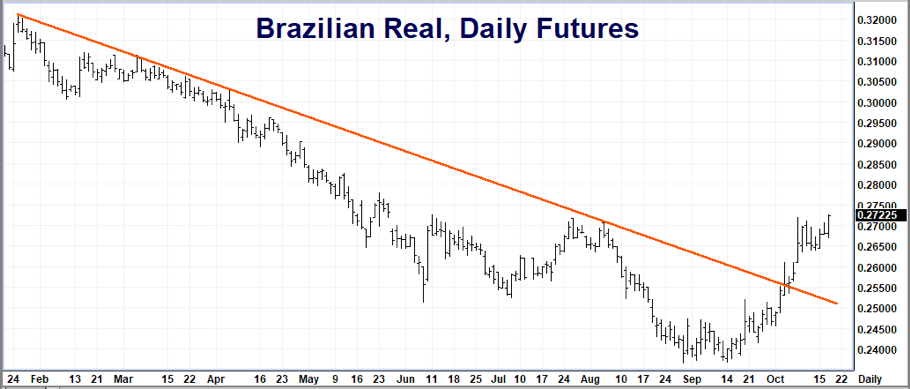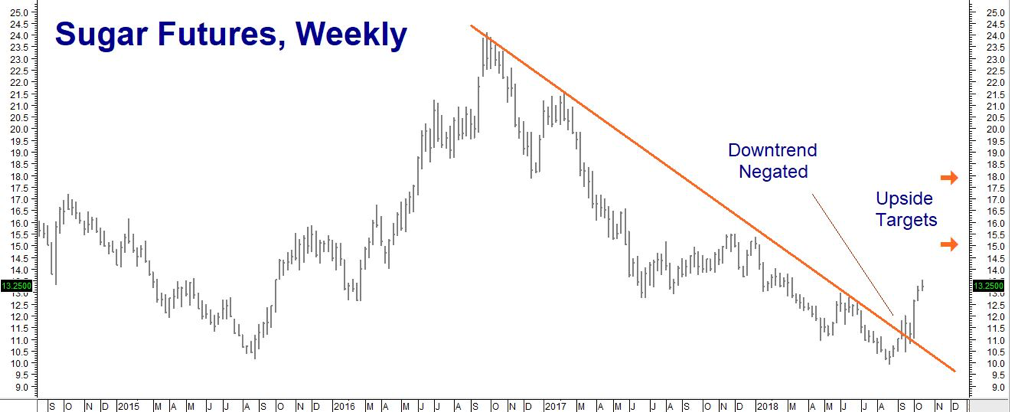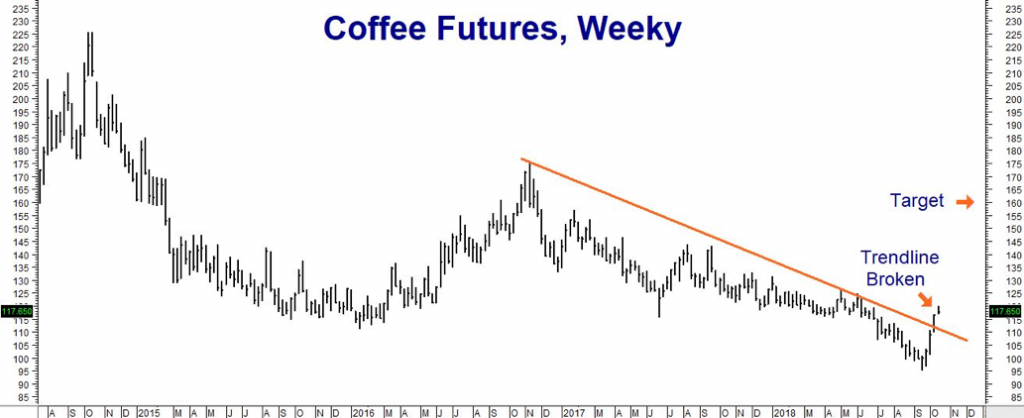The winds are shifting. Critical commodities like corn, soybeans, sugar, hogs and coffee appear to be taking a cue from the energy sector and forming what we believe could be multi-year bottoms in the entire sector. As RMB Group has been pointing out in our Big Move Trade Alert blog posts, commodities have been on sale for a long time. They may not be for much longer. We’ve been recommending longer-term, fixed risk option plays in commodities for the better part of the year and had our patience tested more than once. However it looks like that patience is finally going to be rewarded.
There are three factors that we believe are responsible for today’s young renaissance in commodities:
1) The recovery of emerging market currencies – particularly the Brazilian Real. Brazil is the largest producer of many key commodities, including sugar and Arabica coffee. A weak currency means that is takes fewer dollars to buy the same number of Reals. Farmers get paid for their products in Reals but international buyers pay in dollars. The weaker Real enabled farmers to receive more in terms of their local currency than buyers had to pay in dollars, putting a lot of pressure on the dollar price of many commodities.

Data Source: FutureSource
The big rally in the Brazilian currency during the month of September due to growing expectations of a victory by right wing candidate Jair Bolsonaro in the upcoming presidential election has taken the pressure off the Brazilian Real, negating its downtrend and setting the stage for further upside. An actual victory by Mr. Bolsonaro could cause the Brazilian currency to soar. This would be bullish for many commodities – including soybeans.
2) Changing eating habits combined with an exploding global population puts constant pressure on farmers to produce more each year. There are over 7.5 billion people on the planet right now, which is more than double the amount 60 years ago. Many of these people have been pulled out of poverty by globalization and are beginning to change their eating habits to match that of Western nations. This means more meat, more sweets and, yes, more caffeine. Since meat is basically just grain in another package, demand for corn and soybeans should continue to expand every year.
3) History tells us that good crop-growing weather cannot and will not last. Six years of bumper crops in the US have kept pace with growing global demand – but just barely. Just a small hiccup in global production due to global climate change could send the price of key commodities soaring.
Let’s take a look at some of the markets that we have recommended long-term, bullish option plays in over the past few months and see how they are faring. You can go to the RMB Group Blog to find our original recommendations.
Just a “Sugar High” Or Something More?
Both sugar and coffee are heavily dependent of the fate of the Brazilian Real. Compare the chart below with the chart of the Brazilian Real above and you get a pretty good match – especially during the month of September. But sugar has other things going for it as well. The sweet stuff is still cheap on an absolute basis after testing and bouncing off 10-year lows just below 10 cents per pound.

Data Source: Reuters
Sugar-based ethanol is used as a substitute for gasoline in Brazil. Rising crude and gasoline prices encourage the use of ethanol, leaving less available for export, making the ongoing bull market in crude oil a potentially supportive factor. As always, weather remains a wildcard. Bad weather in either Brazil or sugar-rich India could spark a huge upside sugar rush in a very short span of time.
While sugar looks much better than it did just 30 days ago, the last leg down caused a bit more technical damage to the market than we originally planned for. Consequently, we’ve lowered our upside targets slightly down to 15 cents and 18 cents respectively. The recent rally has taken out old swing highs just below 13 cents per pound, increasing the odds that the market will reach our first objective prior to the expiration of our 14-cent calls on February 15, 2019.
The good news is our March 14-cent calls have finally broken into the black after months of languishing in the red. RMB Group trading customers who own March 2019 14 cent calls may want to consider buying a lot more time by exchanging them for October 2019 15- cent calls. This exchange will cost you nothing and maybe even net you a small credit as we write this. Your position gains 213 days of life following the exchange.
October 15 cent sugar calls will be worth at least $3,360 should sugar hit our 18-cents per pound objective prior to October option expiration and gain an additional $1,120 for each one cent move beyond that. RMB trading customers not holding March 14 sugar calls may want consider buying October 15 cent calls on a pullback. Check with your personal RMB broker for the latest.
Coffee Finally Waking Up
The rally in the Real has perked up coffee as well. Like sugar, there are other reasons to like coffee – besides its stimulating properties. China, and its 1.4 billion people, is quickly developing a taste for the black, bitter stuff. Tariffs or no, Starbucks is making a huge bet on China and is well on the way to its goal of opening 6,000 stores there by 2022.

Data Source: Reuters
Coffee appears to have established a bottom. Like sugar, coffee has bounced off of a new 10-year low after chasing all the longs out of the market. But it is still remains historically cheap. Coffee is also subject to weather disruptions caused by global climate change. Recent price action is also positive. Coffee futures appear to have broken solidly above the downtrend begun almost a year ago.
Our long-term target remains $1.60 per pound. The March bull spreads we recommended back in May are still a fair distance away from our target. Consequently, we will be looking to exit them once we see signs that the current rally in coffee has run its course. We will monitor this potentially explosive market for opportunities to re-enter using longer-dated options.
RMB trading customers who are not holding bullish option spreads in coffee may want to consider establishing longer-term positions on pullbacks. Check with your personal broker for the latest.
Editor’s Note: “Part 2” of this blog will cover our open positions in corn and soybeans. We will also examine the gold market. Is the Midas Metal ready for prime time?
Please be advised that you need a futures account to trade the markets covered in this post. The RMB Group has been helping its clientele trade futures and options since 1984 and are very familiar with all kinds of option strategies. Call us toll-free at 800-345-7026 or 312-373-4970 (direct) to for more information and/or to open a trading account. You can also visit our website at www.rmbgroup.com.
* * * * * * * *
The RMB Group
222 South Riverside Plaza, Suite 1200, Chicago, IL 60606
This material has been prepared by a sales or trading employee or agent of R.J. O’Brien & Associates (“RJO”)/RMB Group and is, or is in the nature of, a solicitation. This material is not a research report prepared by a Research Department. By accepting this communication, you agree that you are an experienced user of the futures markets, capable of making independent trading decisions, and agree that you are not, and will not, rely solely on this communication in making trading decisions.
DISTRIBUTION IN SOME JURISDICTIONS MAY BE PROHIBITED OR RESTRICTED BY LAW. PERSONS IN POSSESSION OF THIS COMMUNICATION INDIRECTLY SHOULD INFORM THEMSELVES ABOUT AND OBSERVE ANY SUCH PROHIBITION OR RESTRICTIONS. TO THE EXTENT THAT YOU HAVE RECEIVED THIS COMMUNICATION INDIRECTLY AND SOLICITATIONS ARE PROHIBITED IN YOUR JURISDICTION WITHOUT REGISTRATION, THE MARKET COMMENTARY IN THIS COMMUNICATION SHOULD NOT BE CONSIDERED A SOLICITATION.
The risk of loss in trading futures and/or options is substantial and each investor and/or trader must consider whether this is a suitable investment. Past performance, whether actual or indicated by simulated historical tests of strategies, is not indicative of future results. Trading advice is based on information taken from trades and statistical services and other sources that RJO/RMB believes are reliable. We do not guarantee that such information is accurate or complete and it should not be relied upon as such. Trading advice reflects our good faith judgment at a specific time and is subject to change without notice. There is no guarantee that the advice we give will result in profitable trades.